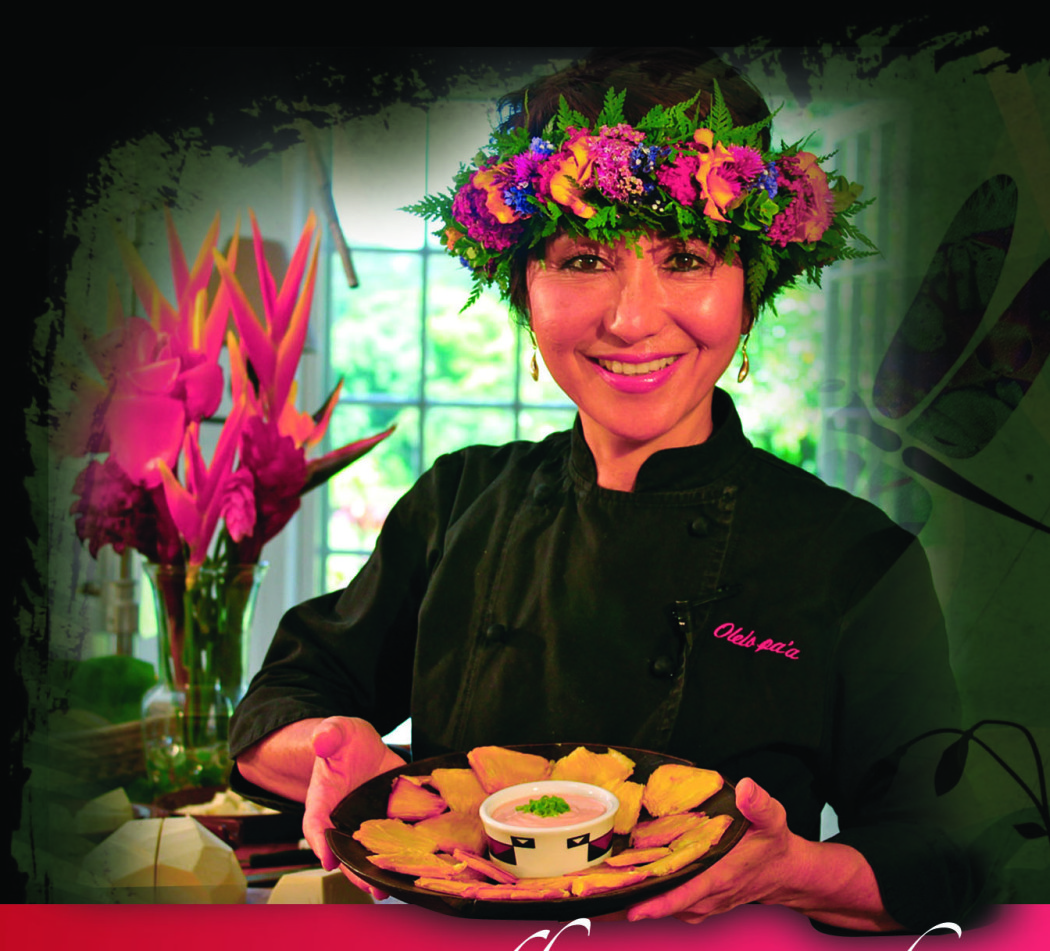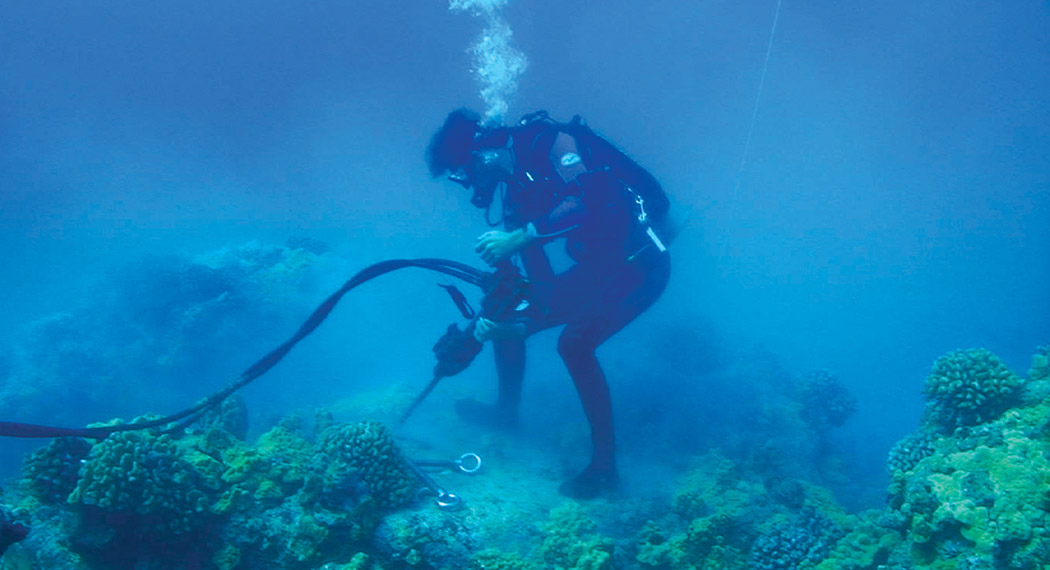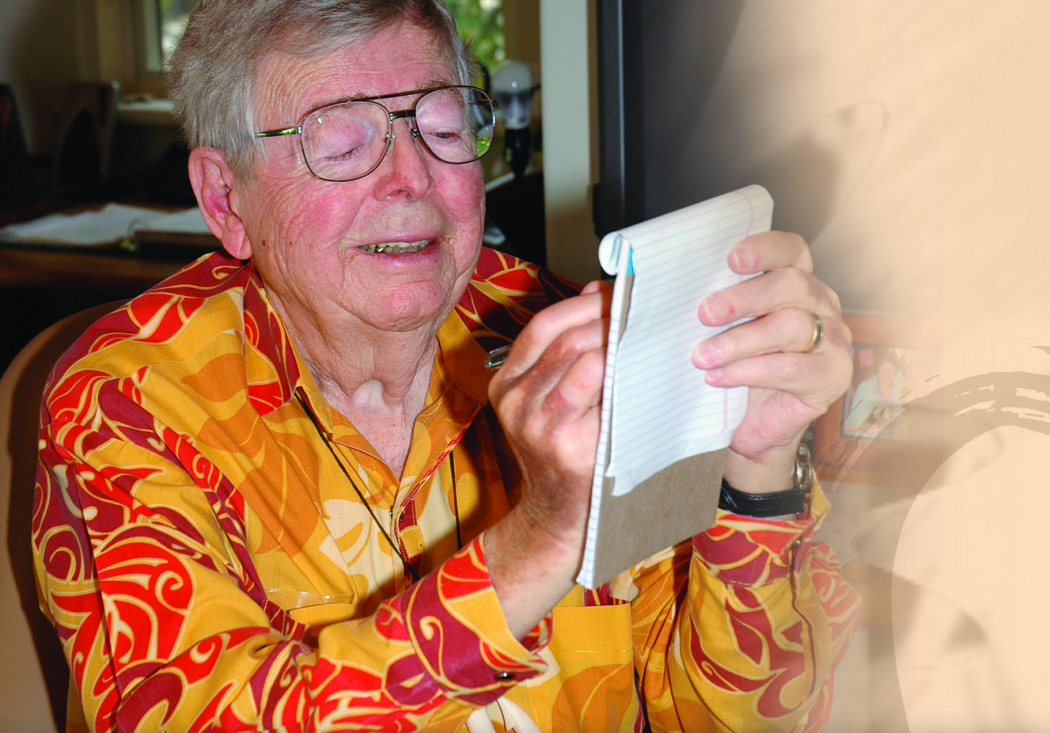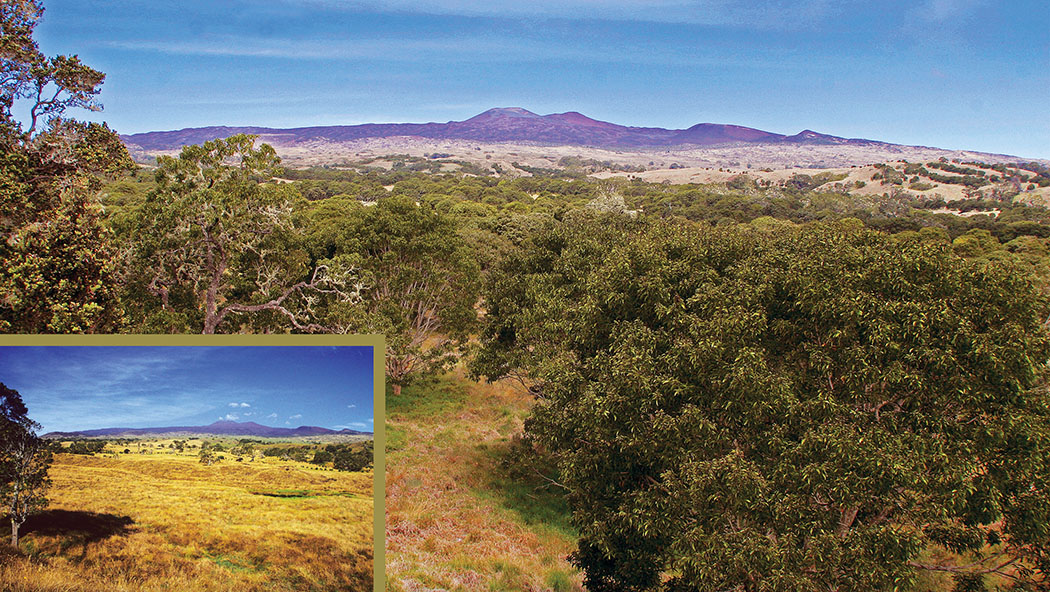
Success! Hakalau Forest Refuge: Scientists and Volunteers Partner to Save Forest Birds

By Fern Gavelek
Hawai‘i’s geographical isolation means that the plants and animals found here have evolved unlike any other species found on earth. Human interaction and interference with once untouched habitats has rendered Hawai‘i the endangered species capital of the world. However, there is a place on Hawai‘i Island where forest bird populations are recovering due to the effort of biologists, refuge managers, and volunteers.
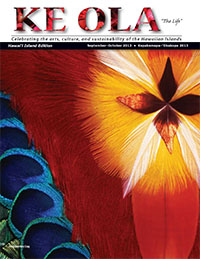
Located high above the tiny town of Hakalau on the eastern flanks of Mauna Kea, the Hakalau Forest National Wildlife Refuge (HFNWR) is home to several endangered bird species and some of the finest remaining stands of native montane rain forests in the state.
Established in 1985, the refuge is the only one of its kind solely dedicated to the conservation of forest birds. Over the last 25 years, an extensive volunteer program replanted native forestry to make it more hospitable to native birds, and as a result, their songs are returning.
To realize the plight of these birds is to understand how birds colonized Hawai‘i. Along with plants and insects, birds first came to the most isolated land on earth on their own, with a new species surviving the long journey only once every 20,000–40,000 years. Over time and adapting to their new environment, these birds became better suited to survive here.
We know birds can fly to Hawai‘i from afar because it happens every fall with the annual arrival of migrating shorebirds like the kōlea or Pacific golden plover, Pluvialis fulva. This seasonal native, which prefers open, grassy areas, is less than a foot tall and flies more than 2,000 miles between Hawai‘i and Alaska to overwinter in the islands.
Recent DNA evidence shows a single colonization of a finch-like bird from Asia is the parent of Hawaiian honeycreepers, according to Jack Jeffrey, a retired wildlife biologist with the U.S. Fish and Wildlife Service (FWS) who worked at HFNWR. This bird came to Hawai‘i five-to-six million years ago, evolving into a unique sub-family of birds with more than 50 species.
Birds, who made it here on their own and evolved to be different than any other species on the planet, are Hawai‘i’s endemic birds. They typically have Hawaiian names, like the endangered state bird: the Nēnē, Branta sandvicensis.
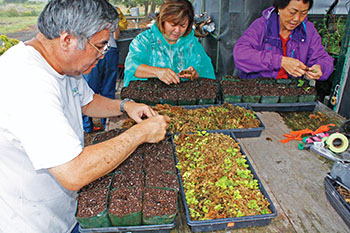
Hawai‘i’s indigenous birds—those who got here on their own and are also found elsewhere—can be spotted at all elevations. Most of these natives, like the ‘auku‘u or black-crowned night heron, Nycticorax nycticorax hoactli, live here year round. Found worldwide, this bird is locally called a “fish hawk;” it hunts near seaside ponds.
Introduced birds, like the Northern cardinal, came to Hawai‘i with man and hail from all over the world. These immigrants commonly live in Hawai‘i’s urban areas and make up its avian melting pot.
Hawai‘i’s endemic forest birds are more elusive. They are found only in high-elevation forests, where colder temperatures deter introduced, disease-carrying mosquitoes. One of the most readily seen of these unique-to-Hawai‘i birds is the scarlett, curved-beak ‘i‘iwi, Vestiaria coccinea. While it is not endangered, this honeycreeper is called a “specialist,” feeding only on nectar.
“The ‘i‘iwi is one of the most important pollinators of our native plants,” notes Jeffrey. “Unfortunately, one bite from a malarial mosquito will result in death for an ‘i‘iwi within two-to-three weeks.”
A mere mosquito bite is tragic because Hawai‘i’s endemic birds lived here in isolation for millions of years, shedding past predatory defenses. They have no resistance to introduced diseases like avian malaria or pox. Other factors contributing to the plight of Hawai‘i’s native birds include loss of habitat; predation by introduced rats, mongoose, cats, and dogs; and competition for food with non-native birds.
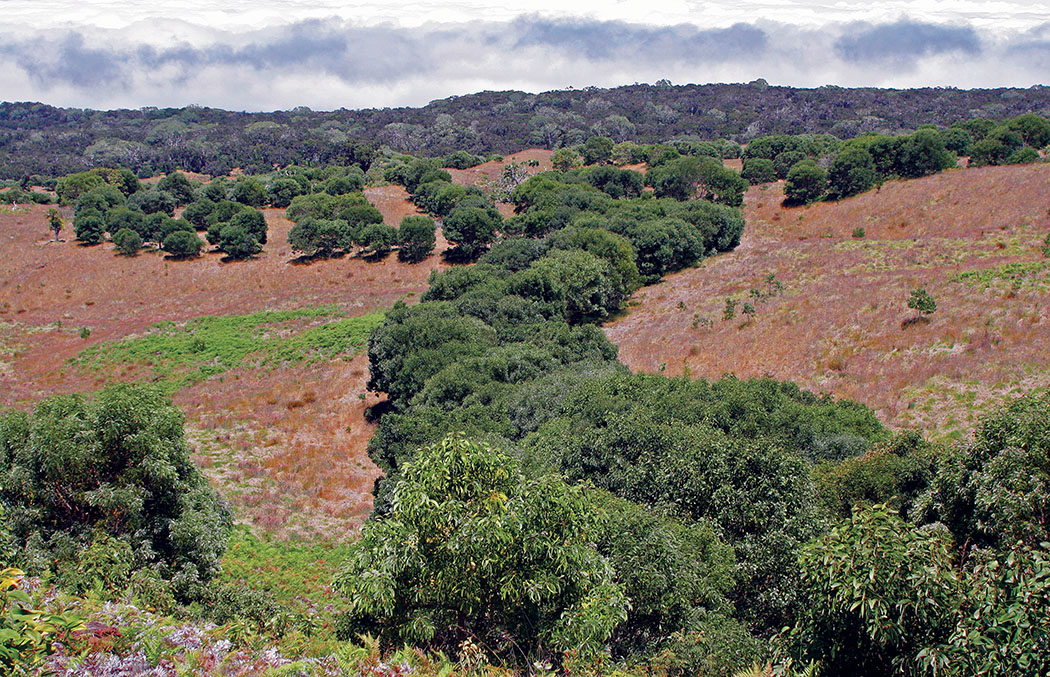
“Out of 120 bird species found in Hawai‘i in the 18th century, half are extinct today,” Jeffrey laments. “Of the remaining bird species, almost half are endangered.”
HFNWR is home to three species of endangered, endemic honeycreepers, including a marvel in the avian world—the ‘akiapōlā‘au, Hemignathus munroi. Considered an “extreme specialist,” this honeycreeper acts like a woodpecker. Most birds can’t move their upper bill as it’s fused to their skull, but this bird evolved so it can use both bills separately, and each has its own specialized function.
“It’s like the ‘aki is outfitted with a Swiss Army knife,” points out Jeffrey. “It uses its lower bill to peck and find the wood boring beetle larvae, then it reaches into the hole with its long, thin, curved upper bill to hook the insect and pull it out.”
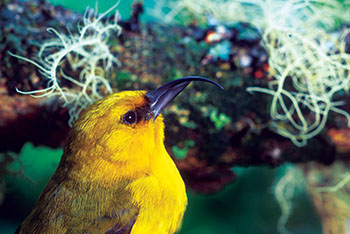
“Many of Hawai‘i’s specialist birds are extinct,” says Jeffrey. “There are less than 1,000 ‘akiapōlā‘au in the Big Isle’s koa forests, which have shrunk considerably due to cattle grazing and logging. However, numbers of ‘aki are increasing at Hakalau and the refuge boasts the highest density of ‘i‘iwi.”
In fact, all the bird species at Hakalau Forest are increasing according to annual surveys done since 1987. “When you fix the habitat, everyone is happy,” notes Jeffrey.
Creating a forest habitat at HFNWR hasn’t been easy. The Hāmākua slope of Mauna Kea was chosen for the bird refuge as the area was already rich in species diversity, with high densities of ‘aki. However, the refuge was formerly a ranch, thick with pasture grass due to 150 years of cattle grazing.
“We fenced in 14,000 acres and removed cows and pigs,” details Jeffrey, who retired from HFNWR in 2008. “Between 1989 and today, the refuge and volunteers have planted tens of thousands of koa trees.”
Help was needed for the daunting task and a weekend volunteer program was started in the late ‘80s. People from all walks of life stepped up to pick koa seeds, nurture seedlings in the greenhouse and then plant the fast-growing koa in mauka to makai (mountain-to-sea) corridors that were three trees wide, spaced 12 feet apart. Volunteers, who hailed from across the globe, started at a 6,500-foot elevation, where there was only pasture, and planted down to 6,000 feet. The new swaths of trees went about a mile and a half in some areas down the mountain, sprawling across 5,000 acres of Mauna Kea.
“The plan was for the birds to use these corridors,” explains Jeffrey. “Early on, it was thought maybe the birds would drop seeds for other native plants to create an understory, but it didn’t happen quickly. So we helped out the effort by planting ‘ōhelo berry, ‘ōlapa, pilo, ‘ākala (Hawaiian raspberry), and others. These plants provided food for birds and then the birds followed.”
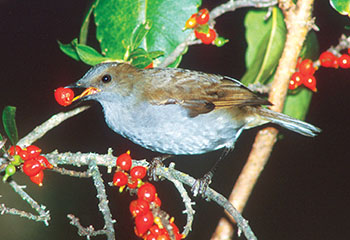
The bird credited for most helping create the understory of the forest is the fruit-eating ‘ōma‘ō, Myadestes obscurus. Known for its lively song, the endemic Hawai‘i Island thrush was luckily already living in Hakalau, and it readily spread seeds through its droppings. Jeffrey said plant seeds germinate better “when they go through a bird’s gut.”
In addition to native fruiting plants, ‘ōhi‘a trees were planted for nectar-loving birds. Isles of vegetation formed and over time, these pockets connected into forest. The planted koa corridors attracted birds up to the higher elevation and their droppings brought seeds. The area below 6,000 feet already had ‘ōhi‘a and koa trees, but the understory was gone due to grazing. By dropping seeds, ‘ōma‘ō helped restore the understory vegetation in this area as plants were no longer vulnerable to cattle.
“The reforestation effort is for all of Hakalau’s forest birds, including the ‘io (Hawaiian Hawk, Buteo solitarius),” notes Jeffrey. It is only found on Hawai‘i Island.
The volunteer service program has been crucial to recovering the refuge’s forest bird populations according to refuge horticulturist Baron Horiuchi. He has been working for 17 years with the many weekend service groups at Hakalau. Horiuchi says groups of 8-10 people, hailing from organizations like hiking clubs and scouts, spend weekends planting seedlings, pulling weeds, and working in the greenhouse. Groups come from across the globe, and some are made up of friends, with fun names like “Girl Power.” Horiuchi says volunteers are dedicated, putting in 10-hour days and often “napping during lunch” as the work can be exhausting.

“We have nearly a half million trees planted in the ground, and without the volunteers, none of this would have happened,” Horiuchi emphasizes. “I want to thank them all for making Hakalau what it is today.”
Longtime volunteer Lorri Ellison of Kea‘au says its been “exceedingly rewarding” to witness the tremendous change at Hakalau in the last 25 years. “We’re seeing and hearing birds now at the volunteer cabin, an area that was grassland when we started,” she details. “The reforestation effort is working.”
While HFNWR is blushing with biological success, it’s facing continuing budget cuts. Volunteer service trips have been cut back to 36 weekends a year, and they are already booked, according to Horiuchi. At this time, he is unable to take any new volunteer groups.
“There is still a lot of work to do,” notes the horticulturist, who is also propagating and planting endangered plants, including three different endemic lobelias. Two of the varieties were in severe trouble, with only a handful living in the wild.
Even though group service availability is closed, Ellison says people can get involved with the refuge by joining the Friends of Hakalau Forest. FOHF helps with fundraising for refuge projects and also does periodic service trips. In the past, FOHF funded a new roof for the volunteer cabin and a water tank. Details for FOHF can be found at their website.
Donations can be made using the membership form, including to the Jack Jeffrey Conservation Education Grant. The grant helps to finance ‘Imi Pono no ka ‘Āina, a conservation-themed educational program that brings keiki to work at the refuge. Started in the mid-90s, the program boasts youth participants that have since made careers in environmental law, education, and science.
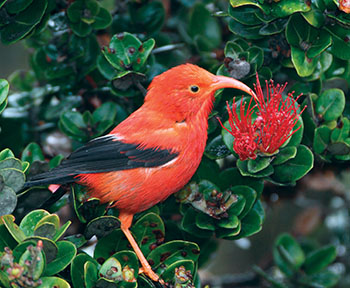
Steve Kendall, HFNWR wildlife biologist, says another way to support Hakalau is to contact local legislators to encourage funding for the refuge. “It’s always a struggle to restore plants and keep out the ungulates,” he notes. “We’re always just getting by each year.”
As Hakalau Forest is a refuge, public access is restricted. However it rolls out the “green carpet” annually for an open house set for 9 am–3 pm, Saturday, October 19. Short, guided hikes are offered through bird habitat and visitors can see the volunteer reforestation efforts, along with the greenhouse. Conservation displays are available, along with a chance to meet FOHF members. Visitors must provide their own four-wheel-drive transport to the refuge and reservations are required, phone 808.443.2300 by October 17. Directions will be emailed.
There are other ways to visit HFNWR. As weather permits, the Maulua Tract is open to visitors for hiking, birding, and photography on weekends and holidays. In addition, a handful of commercial tours offer guided visits.
Ellison concludes, “This is our backyard, and what is happening up there is a tremendous success story. It’s an incredible place of native forest birds, native plants, and a wonderful volunteer effort in support of FWS’s management of this special area.” ❖
For more information: FriendsOfHakalauForest.org
Weekend visits: fws.gov/hakalauforest/visit.html
Photos by Jack Jeffrey: JackJeffreyPhoto.com
Contact writer Fern Gavelek: ferng@hawaii.rr.com
